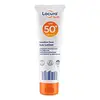What's inside
What's inside
 Key Ingredients
Key Ingredients

 Benefits
Benefits

 Concerns
Concerns

 Ingredients Side-by-side
Ingredients Side-by-side

Water
Skin ConditioningC12-15 Alkyl Benzoate
AntimicrobialOctocrylene
UV AbsorberGlycerin
HumectantButyl Methoxydibenzoylmethane
UV AbsorberDiethylamino Hydroxybenzoyl Hexyl Benzoate
UV FilterTitanium Dioxide
Cosmetic ColorantDimethicone
EmollientDibutyl Adipate
EmollientVp/Hexadecene Copolymer
Tocopheryl Acetate
AntioxidantAcrylates Copolymer
Bis-Ethylhexyloxyphenol Methoxyphenyl Triazine
Skin ConditioningSilica
AbrasiveCaprylyl Glycol
EmollientPanthenol
Skin ConditioningTriacontanyl Pvp
HumectantDimethicone Crosspolymer
Emulsion StabilisingSodium Hydroxide
BufferingDecylene Glycol
Skin ConditioningCitric Acid
BufferingDisodium EDTA
Caprylhydroxamic Acid
Water, C12-15 Alkyl Benzoate, Octocrylene, Glycerin, Butyl Methoxydibenzoylmethane, Diethylamino Hydroxybenzoyl Hexyl Benzoate, Titanium Dioxide, Dimethicone, Dibutyl Adipate, Vp/Hexadecene Copolymer, Tocopheryl Acetate, Acrylates Copolymer, Bis-Ethylhexyloxyphenol Methoxyphenyl Triazine, Silica, Caprylyl Glycol, Panthenol, Triacontanyl Pvp, Dimethicone Crosspolymer, Sodium Hydroxide, Decylene Glycol, Citric Acid, Disodium EDTA, Caprylhydroxamic Acid
Water
Skin ConditioningZinc Oxide
Cosmetic ColorantIsododecane
EmollientNeopentyl Glycol Diheptanoate
EmollientPEG-30 Dipolyhydroxystearate
EmulsifyingAlcohol Denat.
AntimicrobialTitanium Dioxide
Cosmetic ColorantDimethicone
EmollientGlycerin
HumectantC18-36 Acid Triglyceride
EmollientPhenoxyethanol
PreservativePolyglyceryl-3 Diisostearate
EmulsifyingVp/Eicosene Copolymer
Hydroxyacetophenone
AntioxidantAluminum Hydroxide
EmollientStearic Acid
CleansingPolyhydroxystearic Acid
EmulsifyingTocopheryl Acetate
AntioxidantSodium Hyaluronate
HumectantXanthan Gum
EmulsifyingCI 77492
Cosmetic ColorantAloe Barbadensis Leaf Juice
Skin ConditioningHydrated Silica
AbrasiveWater, Zinc Oxide, Isododecane, Neopentyl Glycol Diheptanoate, PEG-30 Dipolyhydroxystearate, Alcohol Denat., Titanium Dioxide, Dimethicone, Glycerin, C18-36 Acid Triglyceride, Phenoxyethanol, Polyglyceryl-3 Diisostearate, Vp/Eicosene Copolymer, Hydroxyacetophenone, Aluminum Hydroxide, Stearic Acid, Polyhydroxystearic Acid, Tocopheryl Acetate, Sodium Hyaluronate, Xanthan Gum, CI 77492, Aloe Barbadensis Leaf Juice, Hydrated Silica
 Reviews
Reviews

Ingredients Explained
These ingredients are found in both products.
Ingredients higher up in an ingredient list are typically present in a larger amount.
Dimethicone is a type of synthetic silicone created from natural materials such as quartz.
What it does:
Dimethicone comes in different viscosities:
Depending on the viscosity, dimethicone has different properties.
Ingredients lists don't always show which type is used, so we recommend reaching out to the brand if you have questions about the viscosity.
This ingredient is unlikely to cause irritation because it does not get absorbed into skin. However, people with silicone allergies should be careful about using this ingredient.
Note: Dimethicone may contribute to pilling. This is because it is not oil or water soluble, so pilling may occur when layered with products. When mixed with heavy oils in a formula, the outcome is also quite greasy.
Learn more about DimethiconeGlycerin is already naturally found in your skin. It helps moisturize and protect your skin.
A study from 2016 found glycerin to be more effective as a humectant than AHAs and hyaluronic acid.
As a humectant, it helps the skin stay hydrated by pulling moisture to your skin. The low molecular weight of glycerin allows it to pull moisture into the deeper layers of your skin.
Hydrated skin improves your skin barrier; Your skin barrier helps protect against irritants and bacteria.
Glycerin has also been found to have antimicrobial and antiviral properties. Due to these properties, glycerin is often used in wound and burn treatments.
In cosmetics, glycerin is usually derived from plants such as soybean or palm. However, it can also be sourced from animals, such as tallow or animal fat.
This ingredient is organic, colorless, odorless, and non-toxic.
Glycerin is the name for this ingredient in American English. British English uses Glycerol/Glycerine.
Learn more about GlycerinTitanium dioxide is a mineral UV filter widely used in sunscreens and cosmetics.
It is one of only two UV filters officially classified as “mineral” by regulatory agencies, the other being zinc oxide.
Titanium dioxide provides broad-spectrum protection mostly in the UVB and UVAII range, with some protection in the UVAI range.
While its UVA protection isn’t as strong as zinc oxide’s, the difference is minor.
A common myth is that mineral UV filters reflect UV light. However, modern research shows titanium dioxide absorbs UV radiation like chemical filters (~95% absorption & 5% reflection).
Thanks to its non-irritating nature, titanium dioxide is suitable for sensitive, acne-prone, or redness-prone skin. It is unlikely to cause "eye sting" like other sunscreen ingredients.
A major drawback of this ingredient is its white cast and thick texture. This is why mineral sunscreens often leave a white cast and are less cosmetically elegant than chemical/hybrid sunscreens.
To improve white cast and spreadability, micronized or nano-sized titanium dioxide is often used.
There are ongoing concerns surrounding nano-titanium oxide's impact on marine ecosystems.
There is no conclusive evidence that any form of titanium oxide (or any other sunscreen ingredients) will cause harm to marine ecosystems or coral reefs. The science is still developing but many consumers are keeping a close eye on this issue.
Please note, many destinations have reef-safety sunscreen rules. For instance, the U.S. Virgin Islands advises all visitors to use non-nano mineral sunscreens.
Nano mineral sunscreens once raised safety concerns about absorption into skin.
Extensive research has shown that they do not penetrate healthy or damaged skin; they remain safely on the surface and the top layer of dead skin (stratum corneum).
You'll likely find titanium dioxide bundled with alumina, silica, or dimethicone. These ingredients help make titanium dioxide highly photostable; this prevents it from interacting with other formula components under UV light.
Learn more about Titanium DioxideTocopheryl Acetate is AKA Vitamin E. It is an antioxidant and protects your skin from free radicals. Free radicals damage the skin by breaking down collagen.
One study found using Tocopheryl Acetate with Vitamin C decreased the number of sunburned cells.
Tocopheryl Acetate is commonly found in both skincare and dietary supplements.
Learn more about Tocopheryl AcetateWater. It's the most common cosmetic ingredient of all. You'll usually see it at the top of ingredient lists, meaning that it makes up the largest part of the product.
So why is it so popular? Water most often acts as a solvent - this means that it helps dissolve other ingredients into the formulation.
You'll also recognize water as that liquid we all need to stay alive. If you see this, drink a glass of water. Stay hydrated!
Learn more about Water